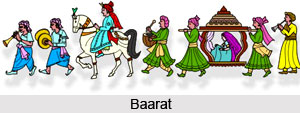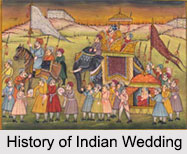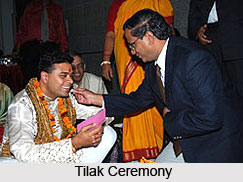 Procession of the bridal pair along the main streets of the village is one of the customs that are peculiar to the Hindus. The husband and the wife who are newly joined in wedlock are carried round the village in a palanquin or a car or on elephant`s backs in howdahs or on horsebacks. The brahmacharis and girls who have attained puberty are also to follow this timeworn custom. The former on the fourteen day of the ceremony, called danduneer and the latter after she bathes at the expiry of the three days after her first menstruation.
Procession of the bridal pair along the main streets of the village is one of the customs that are peculiar to the Hindus. The husband and the wife who are newly joined in wedlock are carried round the village in a palanquin or a car or on elephant`s backs in howdahs or on horsebacks. The brahmacharis and girls who have attained puberty are also to follow this timeworn custom. The former on the fourteen day of the ceremony, called danduneer and the latter after she bathes at the expiry of the three days after her first menstruation.
The palanquin or the car stops in front of each of the houses in the village. The lady inmate of the house or her daughter comes out with a dish of turmeric water mixed with lime, and a cocoanut, plantain fruits, or pan supari. She first presents the occupants of the palanquin or the car with any one of the three items mentioned above and then casts off the effect of the evil eye by waving the mixture of turmeric and lime by the side of the palanquin. This process is repeated at each and every one of the houses. Further, all people in the street are given sandal paste, flowers, fruits and pan supari as well.
The case is something different in the procession of the girl who had bathed after her first menstruation. She is invited inside certain houses and there she is offered milk and fruit. After partaking of these she comes out and gets into the palanquin or the car to dismount again to repeat the process in many other houses.
The customs are appearing to be very fantastic, but these are based on certain principles. In bye-gone days the civilization was quite different to that in vogue at the present time. In European countries the marriage is a contract and not a sacrament as it is with the Hindus. By the procession, one and all in the village are appraised of the marriage of the parties and that is sole intention of doing the custom.
The marriage feast of the Hindus is also proverbial. Feasts accompany every marriage. Almost all the people in the village are invited and fed sumptuously both day and night. At the end of the meal the invitees are given sandal paste, flowers and pan supari.
The services of a piper are also requisitioned for the performance during the marriage rites. Music is supposed to scare away the undesirable invisible beings from the marriage pandals and the premises.
Now-a-days, phaetons drawn by horses and motor cars have taken the place of old palanquins and primitive cars drawn by bullocks. Washington gas lights have taken the place of oil-fed torches. The sight of a palanquin with its decorations of tufts of coloured cotton threads going by the names of kuiijams, etc., has now-a-days become very rare. The primitive cars with their decorations with dolls and tinsels shining in the torchlight like sparklers, frequently seen in villages on marriage occasions.
Pyrotechnic display during and at the time of the procession has also been resorted to drive away unfavorable influences. Regarding the taking in procession round the villages of new brahmacharis and girls that had newly attained puberty, it can be said that it is mainly for visiting the various houses and receiving the blessings of the villagers.
The giving of milk and fruit to the girl taken in procession may be said to signify the hearty wishes of the inmates of the houses for the prosperity of the girl. It is more or less akin to saying `May your marriage come to fruition` or in other words `May you bring forth children who may have enough nourishment`. Fruit in milk mainly denotes children in the midst of plenty.
More on Indian Marriage Customs
See Also
 Procession of the bridal pair along the main streets of the village is one of the customs that are peculiar to the Hindus. The husband and the wife who are newly joined in wedlock are carried round the village in a palanquin or a car or on elephant`s backs in howdahs or on horsebacks. The brahmacharis and girls who have attained puberty are also to follow this timeworn custom. The former on the fourteen day of the ceremony, called danduneer and the latter after she bathes at the expiry of the three days after her first menstruation.
Procession of the bridal pair along the main streets of the village is one of the customs that are peculiar to the Hindus. The husband and the wife who are newly joined in wedlock are carried round the village in a palanquin or a car or on elephant`s backs in howdahs or on horsebacks. The brahmacharis and girls who have attained puberty are also to follow this timeworn custom. The former on the fourteen day of the ceremony, called danduneer and the latter after she bathes at the expiry of the three days after her first menstruation.



















